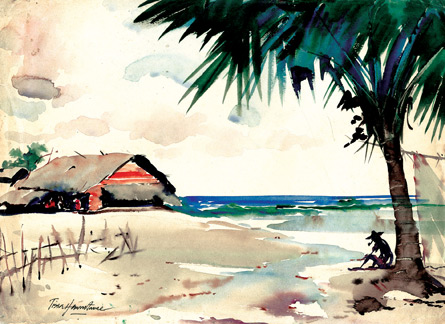What is transparent watercolour?
by Tissa Hewavitarane
Although the watercolour medium is transparent, it need not be watery
or weak. Of course, softness and subtlety are equally important at times
and the medium adapts to those requirements. Only when greatly diluted
with water it becomes transparent. Colours really see through. Slightly
diluted they appear translucent and when applied with little or no
water, they are nearly opaque.
But the term transparent watercolour is used to differentiate the
paints from those with definite opaqueness. The latter use opaque white
to make the colour lighter and are known as gouache, casein, tempera and
show card paint. Transparent watercolour uses no white paint, but the
white of the paper as part of the medium.
 Lighter tints are obtained by thinning the colour with more water,
allowing the white paper to lighten the hue. Acrylic paint may be used
in their way, transparent (when thinned with medium or water) or opaque
(when unthinned). Transparent watercolour then is a method as much as a
material. It is a method of painting that allows the white of the paper
to sparkle through the applied colour. Lighter tints are obtained by thinning the colour with more water,
allowing the white paper to lighten the hue. Acrylic paint may be used
in their way, transparent (when thinned with medium or water) or opaque
(when unthinned). Transparent watercolour then is a method as much as a
material. It is a method of painting that allows the white of the paper
to sparkle through the applied colour.
A method of putting down layers of overlapping colours, like sheets
of stained glass. This overlapping and see-through quality is what gives
watercolour its unique depth and sparkle. The running watery
transparent, overlapping and sparkling effect is the special feel of
watercolour.
General practice
Building from light to dark is the general practice in working with
aquarelle. Light colours go on first, with the whites protected
unpainted. Medium and darker values are brushed on as the painting
proceeds, until the ultimate darkest value is aid on.
This method allows for little or no lightening of areas at a later
time (although that may be done in a number of ways.) Opaque
watercolours can be worked from either light-to-dark because areas can
be painted white or lightened at will.
When we discuss transparent watercolour we will not consider all
watercolours or water soluble media, only transparent and worked in ways
that enhance the medium's transparency.
Tempera, gouche, casein and heavily applied acrylic paint are not
transparent by their nature. They may be extremely thinned with water to
become nearly transparent, and can produce beautiful effects of their
own. But they are not transparent.
Waterbased media are among man's oldest painting substances, dating
back to the cave walls of Atamira, Lascaux, and the Sahara. Tgyptian
scribes diluted colour in water, added a binder and tinted their wall
illustrations. Medieval manu were given life with passages of water
soluble colour.
Mysterious
The mysterious Etruscans decorated their tombs and urns with a
fantastic array of animals and plants, all done in a watercolour of
sorts. Roman and Byzantine artists produced tempera by adding egg to
their mixtures, and painted on wooden panels.
But the greatest contribution on the transparent medium came from the
orient. As early as the 8th century A.D. Nara period, the Japanese were
painting on paper with diluted inks, being influenced by contemporary
Chinese, Indians and Korean developments. Sumie painting is a distinct
art in it self, but it controlled spontaneity is an essential ingredient
in watercolour techniques, and forerunner of later developments.
Renaissance artists, however, were responsible for the new interest
in watercolour because they used it as a sketching medium prior to
making larger oils. It had become a spontaneous and coloured extension
of drawing process, a sort of coloured short hand!
Albrecht Durer thought of watercolours as a finished product not only
preliminary sketches. Rembrandt and Tieplo added to the importance with
vibrant and stimulating works. In France, Delacro used the medium to add
a feeling of immediacy and action to his rapidly stroke sketches.
A method of using watercolour without opaque materials was developed
by Paul Sandby in England in the 18th century and was called aquarelle.
Opaque
Prior to this time, lighter values were achieved by adding opaque
white colour, now the white of the paper became part of the medium, and
transparent watercolour was born in England. William Blake and William
Turner got things rolling a bit later, giving transparent water its
dynamic impetus. Watercolour clubs and societies were formed to aid in
exhibiting artists' works, because the medium was still considered a
sketching material and not as important as oils. In the latter part of
the 19th century American Winslow Hober's series of Bahama paintings
pumped increased zest into aquarelle.
Other Americans Prendergast, Sargent and Demuth in the 19th century
made a significant progress to uplift the medium. Rench impressionists
and post impressionists made extensive use of watercolour, with Cezanne
particularly making vast contributions to the development of the medium.
The Expressionists also found the immediacy of watercolour an asset in
putting their feelings on paper.
|

